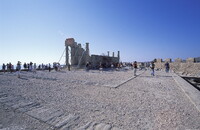| dc.coverage.spatial | Site: Lindos (Rhodes, Aegean Islands, Greece) | en_US |
| dc.coverage.temporal | 5th century BCE (creation) | en_US |
| dc.creator | unknown (Greek (ancient)) | en_US |
| dc.date | -500--400 | en_US |
| dc.date.accessioned | 2013-03-27T15:33:55Z | |
| dc.date.available | 2013-03-27T15:33:55Z | |
| dc.date.issued | -500--400 | en_US |
| dc.identifier | 202411 | en_US |
| dc.identifier.other | archrefid: 1133 | en_US |
| dc.identifier.uri | http://hdl.handle.net/1721.3/110366 | |
| dc.description | Temple of Athena Lindia, general view, from the northeast and at the edge of the upper terrace; The Lindos site is about 55km south of the modern town of Rhodes. Above the modern town rises the acropolis of Lindos, a natural citadel which was fortified successively by the Greeks, by the Romans, the Byzantines, the Knights of St John and the Ottomans. This makes the site difficult to excavate and interpret archaeologically. "Until the late 5th century BCE the island of Rhodes was divided between three city states: Lindos, Kameiros and Ialysos. Lindos and Kameiros each consisted of an urban centre serving as the seat of government, at the foot of an acropolis hill surmounted by a sanctuary of Athena, as well as of various surrounding villages." Source: Grove Art Online; http://www.groveart.com/ (accessed 1/27/2008) | en_US |
| dc.rights | © Scott Gilchrist, Archivision, Inc. | en_US |
| dc.subject | architectural exteriors | en_US |
| dc.subject | Greek (ancient) | en_US |
| dc.title | Lindos; Ancient Greek Acropolis | en_US |
| dc.type | image | en_US |
| dc.rights.access | Licensed for educational and research use by the MIT community only | en_US |
| dc.identifier.vendorcode | 1A3-G-L-LA-G1 | en_US |
| vra.culturalContext | Greek (ancient) | en_US |
| vra.technique | construction (assembling) | en_US |
| vra.worktype | excavation (site) | en_US |
| vra.worktype | temple | en_US |
| vra.worktype | agora | en_US |
| dc.contributor.display | unknown (Greek (ancient)) | en_US |


